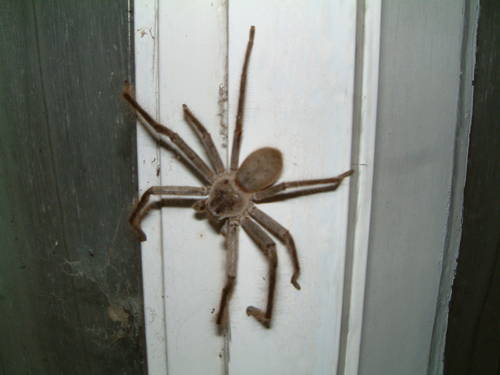Huntsman Spider (Harmless)
Australian Huntsman Spiders
Few of our spiders are better known than the large, sprawling, hairy, long-legged huntsman spiders or, as they are more popularly called, "triantelopes." The general pronunciation, tarantula, is incorrect and misleading, for the spider of that name occurs in southern Europe. Triantelope is therefore preferable since it avoids confusion and has, at least, a typically Australian flavor.
These spiders usually inhabit the bush, where they live under the bark of trees, and may often be found in parties of all sizes. lar ge and small in termingled. Often, heralding a change in the weather, some of these spiders will enter houses and, crawling over thE walls in search of flies and other smal . prey, occasion alarm and unmeritec destruction. In spite of their rather fearsome appearance, they are harm-less, and will take a proffered fly from the fingers in a friendly manner. The commonest species are the large grey and black Isopeda immanis, with strikingly banded legs; the buff Delena cancerides; and the pale fawn and less flattened Olios calligaster, adorned with an orange and black half-moon upon . the lower surface of the abdomen. Olios most frequently lives in gardens, sheltering in nooks such as the leaf-sheaths of lilies. Huntsman spiders will sometimes bite, but the injury is seldom either painful or dangerous.
Few of our spiders are better known than the large, sprawling, hairy, long-legged huntsman spiders or, as they are more popularly called, "triantelopes." The general pronunciation, tarantula, is incorrect and misleading, for the spider of that name occurs in southern Europe. Triantelope is therefore preferable since it avoids confusion and has, at least, a typically Australian flavor.
These spiders usually inhabit the bush, where they live under the bark of trees, and may often be found in parties of all sizes. lar ge and small in termingled. Often, heralding a change in the weather, some of these spiders will enter houses and, crawling over thE walls in search of flies and other smal . prey, occasion alarm and unmeritec destruction. In spite of their rather fearsome appearance, they are harm-less, and will take a proffered fly from the fingers in a friendly manner. The commonest species are the large grey and black Isopeda immanis, with strikingly banded legs; the buff Delena cancerides; and the pale fawn and less flattened Olios calligaster, adorned with an orange and black half-moon upon . the lower surface of the abdomen. Olios most frequently lives in gardens, sheltering in nooks such as the leaf-sheaths of lilies. Huntsman spiders will sometimes bite, but the injury is seldom either painful or dangerous.

